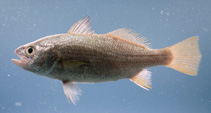| Family: |
Sciaenidae (Drums or croakers) |
| Max. size: |
30 cm TL (male/unsexed) |
| Environment: |
demersal; freshwater; brackish; marine |
| Distribution: |
Western Atlantic: New York to southern Florida in USA, and eastern and northern Gulf of Mexico to northern Mexico. |
| Diagnosis: |
Dorsal spines (total): 10-11; Dorsal soft rays (total): 19-23; Anal spines: 2-2; Anal soft rays: 8-10. Colour silvery, greenish, or bluish above, bright silvery to yellowish on belly. Lower fins mostly yellowish to dusky. Mouth terminal, moderately large and oblique. Chin without barbel but with 6 mental pores (median pair often set in a pit). Preopercle with few spines at angle. Anal second spine sharp, more than 2/3 length of first soft ray. Gas bladder with 2 chambers. Anterior chamber yoke-shaped without appendages, posterior chamber simple, carrot-shaped. Lapillus enlarged, about 1/2 the size of sagitta (Ref 51721). |
| Biology: |
Found in coastal waters over sandy and muddy bottoms. Moves to the nursery and feeding areas in estuaries during summer months and sometimes enters freshwaters. Feeds mainly on crustaceans, worms and occasionally fishes. Mostly used as bait. |
| IUCN Red List Status: |
Least Concern (LC); Date assessed: 27 February 2019 Ref. (130435)
|
| Threat to humans: |
harmless |
Source and more info: www.fishbase.org. For personal, classroom, and other internal use only. Not for publication.

